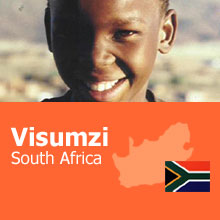Over the past half century, most population growth has occurred in the developing world. In high-birth rate countries such as Kenya, the population not only grows, it grows younger. Forty-three percent of Kenya’s population is under 14, compared to 21 percent for the United States. Populations are similarly skewed throughout Asia and Africa, where at any one time children make up between one-third and one-quarter of the world’s fastest growing populations. But regardless of their location, or their relative numbers, today’s children face serious problems that stem from a distribution of resources that is both unequal and unsustainable.
“I want to bring prosperity to my home.”
When the Earth Summit took place in 1992, South Africa had just emerged from apartheid. Ten years later, the country is still struggling to overcome the inequities of the past. In Thornhill township, where Visumzi was born, electricity has recently arrived, and with it TV. But lamps are no solution to South Africa’s dire health and social issues. Soon after his birth, Visumzi’s father died of pneumonia. His mother’s second husband often got drunk and beat her. An aunt in Pretoria who once sent money has died of AIDS. (In South Africa today, one in nine people are infected with HIV.)
“He’s my friend. He helps me. It doesn’t matter that he’s not the proper color.”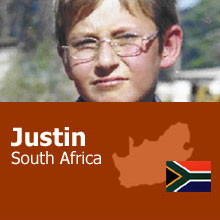
Ten years ago, South Africa’s white minority feared reprisals would follow the lifting of apartheid. For the most part, skillful government policies have prevented mass violence. But the country’s murder rate remains high: 15,000 South Africans were killed in the first nine months of 2001. At Justin’s house, in the fertile lowlands of the country’s Eastern Cape province, dogs warn the family of intruders. Justin’s father sleeps with a loaded gun under his mattress. There is one hopeful sign in Justin’s life, however. His best friend at school is black.
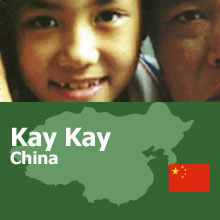 “I want good health for my family. I want lots of money.”
“I want good health for my family. I want lots of money.”
Kay Kay lives with her mother and father in Guangzhou, China. Her father, who works in a paper mill, has done well during China’s rapid industrial expansion. A family income seven times the natural average has paid for a new apartment, and even a motorbike. But China’s progress has come at a price. Growing up amid Guangzhou’s air-born pollutants, Kay Kay is six times more likely to get cancer than is a rural youth. And she spends most of her time alone, as her parents are usually at work or commuting.
 “I’ll put the money in the bank, probably for a month or two. So it builds up.”
“I’ll put the money in the bank, probably for a month or two. So it builds up.”
Stephanie lives in northern California, where her father spent many years in the logging industry. Through much of the past decade her family prospered, which was fortunate, since Stephanie suffers from an eye disease and has needed several operations. But recently, the local lumber mill, the area’s largest employer, has closed down. Her father was laid off. Among the reasons for the closure were the high costs of meeting new environmental standards, designed to halt decades of deforestation, pollution and soil erosion.
 As a result of Egypt’s high birth-rate, the country’s population is child-heavy. More than four million Egyptian children work, typically earning one-sixth the normal adult wage. Often, they have jobs in the most dangerous industries where they face poisoning, burns and sexual abuse and enjoy no legal recourse. There are 1.5 million child laborers in Egyptian agriculture alone. Working 12-hour days, six days a week, such children typically earn around $9 a day, two-thirds of which is kept by their handlers. For this $3 wage, Egypt’s child migrant workers risk poisoning from fertilizers and pesticides. Frequently they are killed or injured during transport in open trailers.
As a result of Egypt’s high birth-rate, the country’s population is child-heavy. More than four million Egyptian children work, typically earning one-sixth the normal adult wage. Often, they have jobs in the most dangerous industries where they face poisoning, burns and sexual abuse and enjoy no legal recourse. There are 1.5 million child laborers in Egyptian agriculture alone. Working 12-hour days, six days a week, such children typically earn around $9 a day, two-thirds of which is kept by their handlers. For this $3 wage, Egypt’s child migrant workers risk poisoning from fertilizers and pesticides. Frequently they are killed or injured during transport in open trailers.
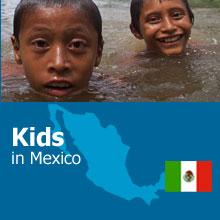 Children make up one-third of Mexico’s population, approximately two-fifths of which lives in poverty (40 million people out of a total of 96 million). Mexico’s poor children face a variety of social problems: 3.5 million of them must work full time for a living; 45 percent quit school after the sixth grade; 170,000 Mexican children are homeless –15,000 in Mexico City alone. (In the cities, crack use and glue-sniffing are epidemic among such children.) Over the past three years, more than 135,000 children have disappeared in Mexico. Authorities fear that most of these “stolen children” end up in prostitution or pornography rings. Fewer than 10 percent of them are ever found.
Children make up one-third of Mexico’s population, approximately two-fifths of which lives in poverty (40 million people out of a total of 96 million). Mexico’s poor children face a variety of social problems: 3.5 million of them must work full time for a living; 45 percent quit school after the sixth grade; 170,000 Mexican children are homeless –15,000 in Mexico City alone. (In the cities, crack use and glue-sniffing are epidemic among such children.) Over the past three years, more than 135,000 children have disappeared in Mexico. Authorities fear that most of these “stolen children” end up in prostitution or pornography rings. Fewer than 10 percent of them are ever found.
 “I’d shoot bandits!”
“I’d shoot bandits!”
Erdo belongs to the Turkana tribe, cattle-rearing nomads who have roamed Kenya for as long as anyone can remember. One of 16 children, Erdo is caught between two worlds. His father wants the children of his three wives to live the traditional life. Erdo’s mother, however, wants a modern life, one safe from armed cattle rustlers who have continually attacked their village. She wants to limit her pregnancies and to educate her children so that they will enjoy greater opportunities. Today, she eeks out an uncertain life, growing crops on a small piece of land. Recently, she lost what money she had saved on a corrupt politician’s investment scam.
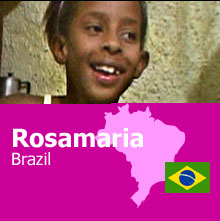 “I’d like a computer to help me do my homework.”
“I’d like a computer to help me do my homework.”
Rosamaria lives in Rocinha, a favela, or slum, near the location of the 1992 Earth Summit in Rio de Jeneiro. She shares a two-room shack with her mother (a chambermaid) and three siblings. Many of the 200,000 people who live in Rocinha, and in Brazil’s other urban slums, are poor farmers, whose inferior hinterland farms cannot compete with industrial agriculture. (In Brazil, just one percent of the population owns 46 percent of the arable land.) In Rocinha, Rosamaria faces pollution, crime and poverty. Still, the slums do offer community, and hope for a better future.
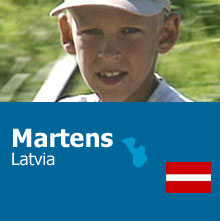 (On games) “We play with guns.”
(On games) “We play with guns.”
Martens lives in Latvia, a former Soviet republic. A healthy 10-year-old, he seems to have escaped the illnesses and birth defects so common in his country — just a few hours drive from the 1986 Chernobyl nuclear disaster site. Latvia itself has suffered acute environmental damage on its Baltic coast. And then there is the Soviet economic legacy. After working double shifts to support his family for the past decade, Marten’s father has lost much of his vision and is unable to work. His mother, now the sole bread-winner, has recently taken a new job on the government’s environmental clean-up task force.
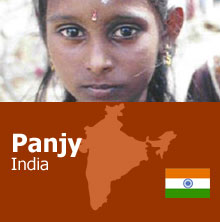 “I want to study to be a doctor and treat people.”
“I want to study to be a doctor and treat people.”
Panjy was born in the village of Manachpuram in the south Indian state of Tamil Nadu. She is an excellent student and dreams of a career in medicine. It is likely, however, that she will leave school very soon. Her family’s poverty may require that she take a job at the local fireworks factory, doing the same work that has already injured her brother and fatally poisoned her father. A decade after India ratified a UN convention pledging to defend human rights, the country continues to employ the world’s largest number of child laborers, an estimated 10 percent of its work force.![]()
![]()
![]()
![]()
![]()
![]()
![]()
![]()

